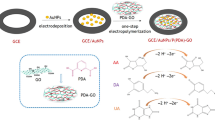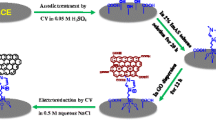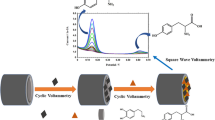Abstract
A surface-graphenized pencil graphite electrode (SGPGE) served as an amperometric sensor for dopamine (DA). It was prepared through a one-step in-situ electrochemical graphene delamination. The graphite particles on the outer surface of the pencil graphite electrode (PGE) were delaminated by controlling the electrochemical delaminating conditions such as the applied anodic voltage and polarization duration, as well as the kind of electrolytes. The best conditions were identified by scanning electron microscopy, Raman spectra, cyclic voltammetry and differential pulse voltammetry (DPV). As a result, the electrode was endowed with an optimum combination of graphene delamination efficiency and electrochemical activity. The electrochemical treatment activates the surface sensing sites and improves the sensing performance. The NaOH-teated anodically graphenized electrode was used to sense dopamine by DPV. The best oxidation voltage of dopamine is at around 0.17 V (vs. SCE). The electrode respondsy to dopamine in the ranges of 0.15 to 45 μM, the detection limit is 8.2 nM (S/N = 3), and the sensitivity is 20.81 μA μM−1 cm−2. In real human urine samples, the sensor exhibited detection recoveries of 97.4–98.8% and low relative standard deviations of 3.49–3.92%.

Schematic presentation of a surface-graphenized pencil graphite electrode (SGPGE) for detecting dopamine. It was prepared by a one-step in situ electrochemical graphene delamination.








Similar content being viewed by others
References
Cai J, Huang J, Ge M, Iocozzia J, Lin Z, Zhang K-Q, Lai Y (2017) Immobilization of Pt nanoparticles via rapid and reusable electropolymerization of dopamine on TiO2 nanotube arrays for reversible SERS substrates and nonenzymatic glucose sensors. Small 13(19). https://doi.org/10.1002/smll.201604240
Masoud T, Roman I, Sergei B, Habib KS, Irina H (2017) Ultra-sensitive voltammetric simultaneous determination of dopamine, uric acid and ascorbic acid based on a graphene-coated alumina electrode. Microchim Acta 184:4603–4610. https://doi.org/10.1007/s00604-017-2510-y
Wu B, Miao C, Yu L, Wang ZW, Huang CH, Jia N (2014) Sensitive electrochemiluminescence sensor based on ordered mesoporous carbon composite film for dopamine. Sensor Actuat B-Chem 195:22–27. https://doi.org/10.1016/j.snb.2014.01.012
Saenz HSC, Hernandez-Saravia LP, Selva JSG, Sukeri A, Espinoza-Montero PJ, Bertotti M (2018) Electrochemical dopamine sensor using a nanoporous gold microelectrode: a proof-of-concept study for the detection of dopamine release by scanning electrochemical microscopy. Microchim Acta 185(8):367. https://doi.org/10.1007/s00604-018-2898-z
Zhu Q, Bao J, Huo D, Yang M, Hou C, Guo J, Chen M, Fa H, Luo X, Ma Y (2017) 3D graphene hydrogel – gold nanoparticles nanocomposite modified glassy carbon electrode for the simultaneous determination of ascorbic acid, dopamine and uric acid. Sensor Actuat B-Chem 238:1316–1323. https://doi.org/10.1016/j.snb.2016.09.116
Lim SK, Chen P, Lee FL, Moochhala S, Liedberg B (2015) Peptide-assembled graphene oxide as a fluorescent turn-on sensor for lipopolysaccharide (endotoxin) detection. Anal Chem 87(18):9408–9412. https://doi.org/10.1021/acs.analchem.5b02270
Yuan Q, Liu Y, Ye C, Sun H, Dai D, Wei Q, Lai G, Wu T, Yu A, Fu L, Chee KWA, Lin CT (2018) Highly stable and regenerative graphene-diamond hybrid electrochemical biosensor for fouling target dopamine detection. Biosens Bioelectron 111:117–123. https://doi.org/10.1016/j.bios.2018.04.006
Novoselov KS, Fal'ko VI, Colombo L, Gellert PR, Schwab MG, Kim K (2012) A roadmap for graphene. Nature 490(7419):192–200. https://doi.org/10.1038/nature11458
Sinha A, Dhanjai JR, Zhao H, Karolia P, Jadon N (2018) Voltammetric sensing based on the use of advanced carbonaceous nanomaterials: a review. Mikrochim Acta 185(2):89. https://doi.org/10.1007/s00604-017-2626-0
Baig N, Saleh TA (2018) Electrodes modified with 3D graphene composites: a review on methods for preparation, properties and sensing applications. Mikrochim Acta 185(6):283. https://doi.org/10.1007/s00604-018-2809-3
Xu Y, Sheng K, Li C, Shi G (2010) Self-assembled graphene hydrogel via a one-step hydrothermal process. ACS Nano 4:4324–4330. https://doi.org/10.1021/nn101187z
Xiong R, Grant AM, Ma R, Zhang S, Tsukruk VV (2018) Naturally-derived biopolymer nanocomposites: interfacial design, properties and emerging applications. Mat Sci Eng R 125:1–41. https://doi.org/10.1016/j.mser.2018.01.002
Chen K, Xue D, Komarneni S (2017) Nanoclay assisted electrochemical exfoliation of pencil core to high conductive graphene thin-film electrode. J Colloid Interf Sci 487:156–161. https://doi.org/10.1016/j.jcis.2016.10.028
Xiong R, Kim HS, Zhang L, Korolovych VF, Zhang S, Yingling YG, Tsukruk VV (2018) Wrapping nanocellulose nets around graphene oxide sheets. Angew Chem 130:8644–8649. https://doi.org/10.1002/anie.201803076
Mihaela B, Alexandra RA, Adriana BI, Adriana B, Ioan S, Constantin M, Alexandru CA (2017) Voltammetric determination of dihydroxybenzene isomers using a disposable pencil graphite electrode modified with cobalt-phthalocyanine. Microchim Acta 184:1481–1488. https://doi.org/10.1007/s00604-017-2153-z
Rezaei B, Boroujeni MK, Ensafi AA (2015) Fabrication of DNA, o-phenylenediamine, and gold nanoparticle bioimprinted polymer electrochemical sensor for the determination of dopamine. Biosens Bioelectron 66:490–496. https://doi.org/10.1016/j.bios.2014.12.009
Gürsu H, Gençten M, Şahin Y (2017) One-step electrochemical preparation of graphene-coated pencil graphite electrodes by cyclic voltammetry and their application in vanadium redox batteries. Electrochim Acta 243:239–249. https://doi.org/10.1016/j.electacta.2017.05.065
Graf D, Molitor F, Ensslin K, Stampfer C, Jungen A, Hierold C, Wirtz L (2006) Spatially resolved raman spectroscopy of single- and few-layer graphene. Nano Lett 7(2):238–242. https://doi.org/10.1021/nl061702a
Ferrari AC, Meyer JC, Scardaci V, Casiraghi C, Lazzeri M, Mauri F, Piscanec S, Jiang D, Novoselov KS, Roth S, Geim AK (2006) Raman spectrum of graphene and graphene layers. Phys Rev Lett 97(18):187401. https://doi.org/10.1103/PhysRevLett.97.187401
Yang S, Bruller S, Wu Z-s, Liu Z, Parvez K, Dong R, Richard F, Samori P, Feng X, Mullen K (2015) Organic radical-assisted electrochemical exfoliation for the scalable production of high-quality graphene. J Am Chem Soc 137(43):13927–13932. https://doi.org/10.1021/jacs.5b09000
Huang X, Li S, Qi Z, Zhang W, Ye W, Fang Y (2015) Low defect concentration few-layer graphene using a two-step electrochemical exfoliation. Nanotechnology 26(10):105602. https://doi.org/10.1088/0957-4484/26/10/105602
Numan A, Shahid MM, Omar FS, Ramesh K, Ramesh S (2017) Facile fabrication of cobalt oxide nanograin-decorated reduced graphene oxide composite as ultrasensitive platform for dopamine detection. Sensor and Actuat B-Chem 238:1043–1051. https://doi.org/10.1016/j.snb.2016.07.111
Kumar Roy P, Ganguly A, Yang W-H, Wu C-T, Hwang J-S, Tai Y, Chen K-H, Chen L-C, Chattopadhyay S (2015) Edge promoted ultrasensitive electrochemical detection of organic bio-molecules on epitaxial graphene nanowalls. Biosens Bioelectron 70:137–144. https://doi.org/10.1016/j.bios.2015.03.027
Wang HH, Chen XJ, Li WT, Zhou WH, Guo XC, Kang WY, Kou DX, Zhou ZJ, Meng YN, Tian QW, Wu SX (2018) ZnO nanotubes supported molecularly imprinted polymers arrays as sensing materials for electrochemical detection of dopamine. Talanta 176:573–581. https://doi.org/10.1016/j.talanta.2017.08.083
Huang S, Song S, Yue H, Gao X, Wang B, Guo E (2018) ZnO nanosheet balls anchored onto graphene foam for electrochemical determination of dopamine in the presence of uric acid. Sensor Actuat B-Chem 277:381–387. https://doi.org/10.1016/j.snb.2018.09.040
Mathew G, Dey P, Das R, Chowdhury SD, Paul Das M, Veluswamy P, Neppolian B, Das J (2018) Direct electrochemical reduction of hematite decorated graphene oxide (α-Fe2O3@erGO) nanocomposite for selective detection of Parkinson's disease biomarker. Biosens Bioelectron 115:53–60. https://doi.org/10.1016/j.bios.2018.05.024
Gonzalez-Dieguez N, Colina A, Lopez-Palacios J, Heras A (2012) Spectroelectrochemistry at screen-printed electrodes: determination of dopamine. Anal Chem 84(21):9146–9153. https://doi.org/10.1021/ac3018444
Anithaa AC, Asokan K, Sekar C (2017) Voltammetric determination of epinephrine and xanthine based on sodium dodecyl sulphate assisted tungsten trioxide nanoparticles. Electrochim Acta 237:44–53. https://doi.org/10.1016/j.electacta.2017.03.098
Qi S, Zhao B, Tang H, Jiang X (2015) Determination of ascorbic acid, dopamine, and uric acid by a novel electrochemical sensor based on pristine graphene. Electrochim Acta 161:395–402. https://doi.org/10.1016/j.electacta.2015.02.116
Gao D, Li M, Li H, Li C, Zhu N, Yang B (2016) Sensitive detection of biomolecules and DNA bases based on graphene nanosheets. J Solid State Electr 21(3):813–821. https://doi.org/10.1007/s10008-016-3423-0
Wang Y, Huang Y, Wang B, Fang T, Chen J, Liang C (2016) Three-dimensional porous graphene for simultaneous detection of dopamine and uric acid in the presence of ascorbic acid. J Electroanal Chem 782:76–83. https://doi.org/10.1016/j.jelechem.2016.09.050
Yang Z, Liu X, Zheng X, Zheng J (2018) Synthesis of au@Pt nanoflowers supported on graphene oxide for enhanced electrochemical sensing of dopamine. J Electroanal Chem 817:48–54. https://doi.org/10.1016/j.jelechem.2018.03.062
Feng X, Zhang Y, Zhou J, Li Y, Chen S, Zhang L, Ma Y, Wang L, Yan X (2015) Three-dimensional nitrogen-doped graphene as an ultrasensitive electrochemical sensor for the detection of dopamine. Nanoscale 7(6):2427–2432. https://doi.org/10.1039/c4nr06623e
Basiri S, Mehdinia A, Jabbari A (2018) Green synthesis of reduced graphene oxide-ag nanoparticles as a dual-responsive colorimetric platform for detection of dopamine and Cu2+. Sensor Actuat B-Chem 262:499–507. https://doi.org/10.1016/j.snb.2018.02.011
Devaramani S, Sreeramareddygari M, Reddy MR, Thippeswamy R (2017) Covalently anchored p-aminobenzene sulfonate multilayer on a graphite pencil lead electrode: a highly selective electrochemical sensor for dopamine. Electroanal 29(5):1410–1417. https://doi.org/10.1002/elan.201600627
Acknowledgements
This work was financially supported by the National Natural Science Foundation of China (Nos. 21176102, 21176215, 21476136, 21171035), the Science and Technology Commission of Shanghai Municipality (No. 15430501200), the Sino-German Center for Research Promotion (No. GZ935), and the Innovation Program of Shanghai Municipal Education Commission (No. 14ZZ160).
Author information
Authors and Affiliations
Corresponding authors
Ethics declarations
The author(s) declare that they have no competing interests.
Additional information
Publisher’s note
Springer Nature remains neutral with regard to jurisdictional claims in published maps and institutional affiliations.
Electronic supplementary material
ESM 1
(DOCX 121 kb)
Rights and permissions
About this article
Cite this article
Fan, X., Xu, Y., Sheng, T. et al. Amperometric sensor for dopamine based on surface-graphenization pencil graphite electrode prepared by in-situ electrochemical delamination. Microchim Acta 186, 324 (2019). https://doi.org/10.1007/s00604-019-3430-9
Received:
Accepted:
Published:
DOI: https://doi.org/10.1007/s00604-019-3430-9




